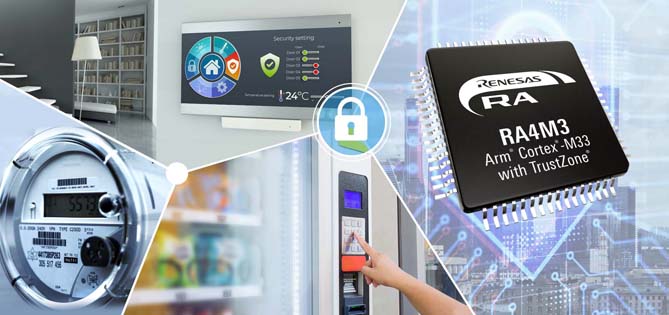Renesas expands MCUs to tackle secure IoT edge uses
- December 16, 2020
- Steve Rogerson

Japanese chip company Renesas Electronics has expanded its RA4 series of microcontrollers (MCUs) to make it easier to develop safe and secure IoT edge devices for low-power applications, such as in security, metering, industrial and HVAC.
The 32bit RA4M3 group of MCUs boost operating performance up to 100MHz using the Arm Cortex-M33 core based on Arm v8-M architecture. They use Arm TrustZone technology, Renesas’ Secure Crypto Engine and a suite of memory enhancements.
“I am excited about the rapid expansion of the Renesas RA MCU family following our RA6M4 MCU group introduction last October,” said Roger Wendelken, senior vice president at Renesas. “While RA6M4 target applications demand superior performance and advanced security, the RA4M3 group offers a well-balanced combination of performance and power consumption with the same advanced security and safety. In addition, customers can take full advantage of the flexibility for memory expansion options that are typical for a broad range of industrial and IoT applications that require continuous innovation.”
The RA4M3 group is designed for low-power IoT applications that require a balance of performance, security and higher memory. The MCUs combine TrustZone technology with the Secure Crypto Engine, enabling users to realise secure element functionality in a wide variety of IoT designs.
The Secure Crypto Engine incorporates multiple symmetric and asymmetric cryptography accelerators, key management, security lifecycle management, power analysis resistance and tamper detection.
The MCUs drive power consumption down to 119µA/MHz in active mode running CoreMark from flash memory and 1.6mA in standby mode with standby wakeup times as fast as 30µs, which can be critical for IoT applications operating in the field for extended periods.
For memory-intense applications, designers can combine Quad-SPI and SD-card interfaces with the MCUs’ built-in embedded memory to increase capacity. The background operation and flash bank SWAP option is suitable for memory optimised firmware updates running in the background.
The increased embedded RAM with parity/ECC also makes the MCUs suitable for safety-critical applications. Several integrated features lower BoM costs, including capacitive touch sensing, embedded flash memory densities up to 1Mbyte, and analogue, communications and memory peripherals.
Key features include:
- 100MHz Arm Cortex-M33 with TrustZone technology on a 40nm process
- Integrated 1Mbyte flash memory, 128kbyte RAM, 8kbyte data flash and 1kbyte stand-by SRAM
- Operating current of 119μA/MHz in active mode and 1.6mA standby current with 30µs wakeup time
- Background operation and block SWAP function for the flash memory
- Capacitive touch sensing unit
- Multiple interfaces including Quad SPI and SDHI memory interfaces, SSI, USB 2.0 Full Speed, SCI and SPI/I2C
- Scalable from 64 to 144-pin LQFP packages including LGA- and BGA-ready options
Together, the group with a flexible software package (FSP) allows the re-use of legacy code combined with software from across the Arm and the RA ecosystems to speed implementation of complex connectivity and security functions.
The FSP includes FreeRTOS and middleware, offering a device-to-cloud option for developers. These out-of-box options can be replaced and expanded with any other RTOS or middleware.
The FSP provides efficiency enhancing tools for developing projects targeting the RA4M3 MCUs. The e2 Studio integrated development environment provides a familiar development cockpit from which the key steps of project creation, module selection and configuration, code development, code generation, and debugging are all managed. The FSP uses a GUI to simplify and accelerate the development process.





